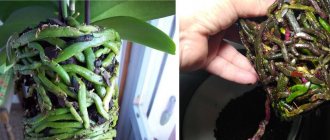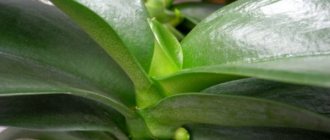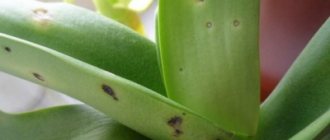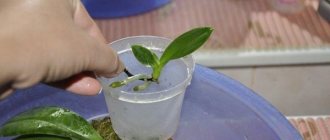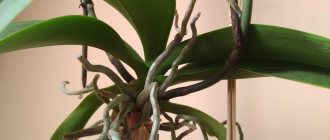Rules for caring for phalaenopsis
With proper and proper care, phalaenopsis will certainly delight you with its moth flowers, presented in a wide variety of shades. This type of orchid is considered unpretentious, although there are certain rules for growing the plant.
Phalaenopsis loves warmth and moderate humidity (up to 45%), does not tolerate direct sunlight, and requires a special approach to its own root system. In nature, there are phalaenopsis of epiphytic and lithophytic species, and this must be taken into account when growing orchids at home.
Such orchids thrive in diffused lighting, which can be provided through artificial lighting. The temperature regime is strict – in the range from +16ºC to +30…+31 ºC. The temperature should not drop below, this is detrimental to the plant. If it is above +31ºC, the flower will begin to actively grow leaves, but problems will arise with flowering.
The roots of phalaenopsis suffer the most from improper care, and as a result, the entire plant develops poorly and dies. Damage and rotting of the orchid root system occurs due to various reasons:
- overflow;
- low temperature;
- insufficient watering;
- poor lighting;
- poor quality substrate.
Hypothermia, overheating, desiccation of the substrate - all this also affects the condition of the flower roots. Sometimes phalaenopsis with underdeveloped roots is bought in a store, in other cases the root system begins to hurt even after home care. If measures are taken in time, the flower can be saved
How to understand that the root system is not functioning?
Phalaenopsis is a fairly viable plant, so you may not suspect that something is wrong with it for a long time. If you notice any changes in the condition of the flower, for example yellowed leaves, you should remove it from the flowerpot and inspect the root system.
Living and healthy roots should be green or white; if there is not enough light, they can be brownish, always hard and dense to the touch, while rotten roots crumble under your fingers and become hollow. If you press on them, moisture will be released, and if the situation is completely advanced, they will crawl under your fingers. In this case, the root system can no longer be saved.
“Phalaenopsis without roots” is a plant falling apart with a dying bottom and a few leaves near the growing point. It is necessary to immediately cut off everything that has rotted and dried out, and begin resuscitation of the flower.
Reanimation of Phalaenopsis
Things are not always so dire and it happens that the phalaenopsis has several tiny roots preserved. Then it is simply transplanted into another container with mandatory fastening.
If most of the roots (up to 95-98%) are missing, you will have to try to revive the flower. In most cases, if you do everything correctly and be patient, the phalaenopsis will survive, its root system will grow back, and it will once again bloom.
Several different ways to resuscitate orchid roots are proposed, and a number of preparatory measures must be carried out:
- prepare cutting tools (with mandatory disinfection with alcohol);
- carefully clean the roots of the flower, remove all damaged and rotten parts, leaving only the living root;
- Be sure to treat all cut areas on the roots with a special powdered fungicide or crushed charcoal.
ON A NOTE!
To treat root sections, you can use regular cinnamon. If the plant has dry or slightly wilted leaves, there is no need to trim them. You can cut off the flower stalks, leaving only the lower part of the arrow.
Greenhouse
To revive the roots of phalaenopsis, it is necessary to create greenhouse conditions (and this is not for the sake of words, but just like that). At home, the role of a greenhouse can be played by:
- a trimmed bottle made of ordinary plastic (it is better to take large containers, 5 or 10 liters);
- aquarium.
The essence of the method is that conditions are created for the orchid in which they grow in nature: warmth, diffused lighting, optimal humidity levels. The greenhouse is placed in a well-lit place, but the hot rays of the sun are avoided.
The optimal room temperature should be around +22ºC…+28ºC. A little expanded clay is poured inside the container, sphagnum is laid and phalaenopsis is placed on top. The place where its roots grow should be in moss.
The improvised greenhouse is ventilated daily, and to keep the humidity level stable, a glass of hot water is placed inside the bottle or aquarium.
When using the “greenhouse” method, phalaenopsis can produce the first roots in about two weeks. If everything is done correctly (and the process can take from one month to a year), the orchid will give good strong roots. When their length is about 4-5 cm, the phalaenopsis can be taken out of the greenhouse and planted in a pot.
In water
Many experienced gardeners grow orchid roots in water. The options may also be different, so let’s consider everything in order.
Alternating soaking and drying
With this method, external conditions are preserved:
- the flower in the container is in a lighted place (but not in direct sunlight);
- air temperature is ensured +25…+26 ºC.
To immerse phalaenopsis in water, select a transparent container and place the plant so that the base of the roots is higher than the bottom.
Every day in the morning, pour a little water into the bottom of the container so that the roots of the plant are in it. After 6-10 hours, the water is drained, leaving the flower in this state until the next morning. In the morning the procedure is repeated again.
ON A NOTE! It is advisable to add special preparations (for example, kornevin) and fertilizers containing potassium and phosphorus needed by the plant to the water.
Also, honey, sugar, and glucose are added instead (no more than one teaspoon per liter of water).
Always in the water
Another method involves keeping the plant in water constantly, and changing the liquid every 5-6 days. This option is least suitable for orchids, since plants take a long time to grow roots, often rot, and even if they survive, they take root very poorly in substrates.
Above the water
Another way is to grow phalaenopsis roots above water. Similar to the first option, when drying and soaking is used, but in a different format. The plant is placed in a container of water, with the base of the roots above the surface of the water and not touching it. The container is closed from above.
Every day the plant is taken out (for example, in the morning), the roots are soaked in water with added sugar, then taken out, dried and placed again in a container over water.
IMPORTANT! The duration of soaking in sweet water is 60 minutes.
Upside down
A method is also used when it is not the base of the phalaenopsis roots that is immersed in water, but its leaves. To do this, you need to carefully place the plant in a container where water has already been poured. In this case, the leaves should be immersed in water only one third.
The base of the roots is exposed to air.
Every day, the upper part of the plant is irrigated with warm water from a spray bottle. In about 30-40 days, the phalaenopsis will produce the first roots.
ON A NOTE! Activated carbon must be added to the water where the leaves are immersed.
After the first roots appear at the base, the plant is placed in a transparent pot with sphagnum moss, where it will grow further. This option is convenient because not only the roots of phalaenopsis actively grow, but new leaves are preserved and even appear.
In the substrate
Very often, gardeners revive the roots of phalaenopsis not in water, but in special substrates. Many say that this option is more suitable for plants that have at least small (2-3 cm) roots. But for plants without roots, growing in a loose substrate can also be successful.
The general rules are:
- any substrate for phalaenopsis must be moist (but without excess moisture content);
- It is useful to spray orchid leaves for better growth with a special solution with vitamin B1.
Types of substrate for growing phalaenopsis roots:
- tree bark (fine fraction materials are used, which must be well steamed and dried);
- a mixture of fine expanded clay, crushed bark, sphagnum (expanded clay is used as a drainage layer);
- tightly compacted sphagnum moss.
If the plant was completely devoid of roots, then it will take a long time for regrowth - up to 10-12 months. In phalaenopsis, which have at least tiny roots, the process goes faster.
You may be interested in: How to care for orchids in a pot after purchase Why the leaves of an orchid wither and how to save it Features of the care and propagation of the Dendrobium Nobile orchid
On the bark
This method is rarely used, since the plant needs to create optimal humidity levels. In dry air, roots will not grow.
Phalaenopsis must be fixed on a piece of bark, and to stimulate growth, treat the plant with a special solution with vitamin B1. There is no need to water or even spray the flower.
The period for roots to appear is three months, but it is quite possible that there will be a longer wait.
Plant resuscitation
How to properly grow strong roots in a baby orchid
The orchid is dying, the roots have rotted: what to do? If there has been loss of root mass, you can try growing new roots above water. The reason may be different, but an orchid cannot exist without roots, and therefore it is worth starting to restore them.
Method of growing roots in water using activated carbon and root former
Now in specialized stores there are many preparations that help grow roots. One of the popular ones in demand is the drug “Kornevin”. This is a hormonal drug that helps the roots break through to the surface of the plant.
If the orchid does not have roots, you need to help it grow new ones. Correct use of the drug on orchids:
- When all rotting places on the flower have been removed and it has dried for 8 hours, “Kornevin” is applied to it, powdering the place on the neck where the roots should be located;
- At the same time at 200 gr. add one tablet of activated carbon to the water and place an orchid treated with Kornevin in it.
The container with the reanimating flower should be in a warm and well-lit place, and as soon as roots appear, it is planted in a substrate with fine bark with the addition of sphagnum moss.
Method of growing roots above water
How to save an orchid if the roots are rotting? To do this, you need to complete all the points of the resuscitation plan without skipping a single step. Because an unfulfilled recommendation can lead to the death of the flower:
- We take the plant out of the old substrate and examine the remains of the roots;
- After the roots have rotted, you need to trim off all rotten and dry roots, using sharp scissors or pruning shears disinfected in alcohol. If the rot has affected part of the neck, then it must be cut off to a healthy body;
- After processing, treat the cuts with activated charcoal or charcoal to protect the flower from rotting;
- Now you need to leave the flower for 8-10 hours so that all the wounds dry well;
- It is necessary to select a glass vessel such that the plant placed in it does not touch the water with its neck. The distance from the neck to the water should be 2-3 cm. If the flower sits in the water, rotting will continue;
- The water must be free of impurities, well filtered or boiled;
- We place the plant so that the place is well lit, but without direct sunlight;
- During resuscitation, the leaves almost always lose their turgor, but this is not a problem, because due to them the root mass of the plant is restored.
IMPORTANT! To make it easier for the plant to regain its strength, you can wipe the leaves with succinic acid every day and spray its leaves with Epin once a month. In about a month, the beginnings of new roots will appear.
Greenhouse and raw moss
When growing roots, you can get by with:
- Sphagnum moss;
- And a greenhouse.
To do this, take a plastic transparent bottle and make an incision approximately in the middle of its height. The cut is not made to the end of the circle; it will, as it were, fix the two parts of the bottle together.
Place sphagnum moss at the bottom of the bottle and moisten it with water. The orchid is placed higher so that its neck does not reach the moss by about 4-5 cm. After which the bottle is secured with tape. The improvised home greenhouse is ready.
It is placed in a bright and warm place, but without direct sunlight. There is practically no need to monitor the moisture content of the moss, since all the moisture remains in the greenhouse, and therefore the moss has sufficient moisture. In about a month, young roots will appear on the plant.
IMPORTANT! When the roots reach 5 cm in length, the flower is transferred to cultivation in the substrate necessary for it.
Using succinic acid
When the process of root growth occurs, the plant often loses leaf turgor. And to slow down the process, a solution of succinic acid is used. It can be purchased at a pharmacy.
Succinic acid is good for growing orchid roots.
It is sold in the form of tablets and has a low cost of 10-12 rubles. To make a solution for wiping foliage, dilute 1 t in 200 g. warm water. The solution is changed every other day. You need to wipe the leaves with the solution every morning.
You can soak the roots in a solution of succinic acid, but in this case the solution is 1 t per liter of water.
How to grow roots in phalaenopsis
As you can see, it is not so difficult to grow roots from this orchid, which is quite common in home floriculture. The methods are quite accessible, and if you perform all the steps correctly and have patience, the flower will definitely reward you with its blooming.
To obtain a good result, it is necessary to use special preparations to stimulate root growth. All of them are sold in specialized stores, and warm, clean water is used to prepare solutions.
Ribav-Extra
Positioned as a root former, used to treat plants, and also as an anti-stress agent.
Allows you to increase productivity and germination of seed material. In the case of phalaenopsis, it stimulates root formation and promotes better plant survival.
Used for orchids: add two drops of the drug per liter of water.
Zircon
It is a universal drug that is used to stimulate plant growth and stimulate root formation. It is part of the group of phytohormones and is considered an effective supplement. The drug is based on an extract from the Echinacea purpurea plant.
Application for phalaenopsis: four drops of the drug are diluted in a liter of water.
Radifarm
A special preparation based on various plant extracts. It is a stimulator of root growth, increases the rooting of plants, and increases their survival.
For orchids, use the following composition: dilute one drop of Radifarm per liter of water.
Etamon
It belongs to a new generation of preparations, is a stimulator of root growth, and provides the plant with quickly digestible forms of nitrogen and phosphorus.
For orchids, use the following composition: take one ampoule of Etamon per liter of water.
Common mistakes
Even experienced gardeners can make mistakes, especially when caring for plants such as orchids. Despite all the unpretentiousness of phalaenopsis, certain rules must be followed, especially during such a process as growing roots.
- The orchid must be in a well-lit place. Direct sunlight is excluded, but the lighting must be sufficient. If the plant does not have enough light, it will go into long hibernation or die.
- Phalaenopsis needs certain humidity indicators, and the roots and base of the roots are not allowed to be constantly in water.
- Do not treat root sections with iodine or brilliant green solution. This can cause the roots to dry out or even burn.
- Withered and drying leaves on phalaenopsis are not cut off. While growing roots, the plant will also absorb nutrients from the leaves.
And you should never be too zealous: add more light to orchids, water the plants heavily. It is necessary to carefully study the information and only then act.
For what reasons may there be no layering?
The baby appears on the mother plant, and how strong and developed the cuttings will be depends on the care of the adult orchid.
Read more about which parts of the flower a baby can form on and how to understand that it has appeared here.
Let us list the reasons why small plants turn out to be underdeveloped:
- Insufficient lighting.
If an orchid has a baby, it needs a lot of light. It is worth making sure that daylight hours last for at least 12 hours, while the sun's rays should be as diffused as possible. If the baby appears in the fall, after flowering, then you need to organize additional lighting. - Incorrectly selected fertilizers that are not suitable for orchids. But sometimes the cause can be untimely feeding. If a plant has a shoot, it requires a lot of nutrients to nourish it.
- Untimely and poor watering. If the plant does not have enough water, then even small rudiments of roots can simply dry out, since moisture does not reach them.
If you review the rules of care, then perhaps the roots will appear soon.
Growing roots in water
The methods listed above for growing plants using water are the simplest. They are accessible even to novice flower growers; you just need to prepare all the necessary items in advance.
Plastic bottles, glasses, jars are used as containers for placing phalaenopsis, selecting their volume taking into account the size of the flower.
The following are used as additives in water used to grow orchid roots:
- Fitosporin;
- Kornevin;
- honey;
- sugar;
- any B vitamins.
ON A NOTE! All drugs are diluted in water, which must be settled and warm.
To improve the condition of phalaenopsis, wipe the leaves with a regular cotton pad. It is pre-moistened in an aqueous solution of succinic acid.
Preparation of the solution: dissolve one tablet of acid per glass of water.
Orchid leaves are wiped from the top and bottom sides. The solution is used for 3-4 days, then it is replaced with a new one. The procedure is carried out in the first half of the day, when the leaves are ready to completely absorb the beneficial solution.
Why is this processing needed? Succinic acid helps increase plant immunity, restore disrupted vital processes, activates root growth, and accelerates the formation of green shoots. The drug is effective even in small concentrations, and is absolutely harmless.
ON A NOTE! Succinic acid is then used in ordinary orchid care (spraying plants).
When the air temperature in the room changes (for example, when it drops), it is necessary to place the phalaenopsis in a bag (directly with the container) so that the plant is comfortable.
Resuscitation on the cortex
This is a very rare way to root phalaenopsis. Sometimes it gives a successful result.
- Pre-prepared bark is poured into a small container, a simple pot. It is pre-steamed and treated with fungicides. This will prevent fungal infection.
- Remove all damaged roots from the base, leaving only healthy ones.
- Using strips cut from unnecessary nylon tights, the leaves with the base are tied to thin sticks installed on opposite sides of the pot.
- The growth zone of the flower roots remains on the surface, pressed against the bark.
- There is no need to moisten the substrate or spray the shoots.
In a few weeks there will be progress. Too dry indoor air is dangerous with this rooting option. It is recommended to place plastic glasses with liquid near the pot. It will evaporate, promoting higher humidity levels and better root formation.
Orchid lighting
Phalaenopsis is not one of those orchid species that are very sensitive to light. It will be enough to follow a number of rules for the plant to develop correctly and please its owners.
- The optimal number of light hours for this type of orchid is 12. At the same time, starting in the fall and throughout the winter, the plant must be supplemented with additional light.
- Lighting should be diffused, direct sunlight (especially in the summer season) should be excluded.
- In an apartment, orchids grow best on western and northeastern windows (summer), and in winter they should be moved to southern and southwestern window sills.
- Over time, Phalaenopsis may lean slightly towards the light source. To prevent changes in the structure of the flower, it is necessary to rotate the plant very carefully (about every two to three weeks).
IMPORTANT! You cannot move the flower during budding! This may cause the buds to drop.
Do not place pots with orchids in bright light. In nature, most phalaenopsis grow surrounded by tropical trees, receiving a minimum of light. Therefore, intense illumination is only harmful to them.

